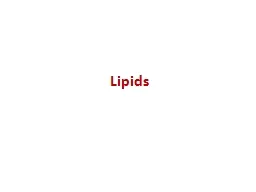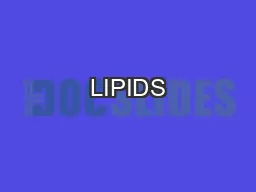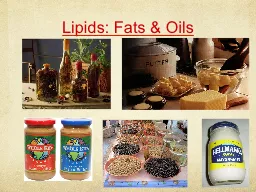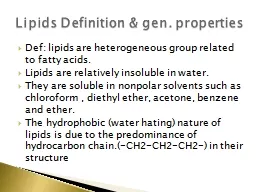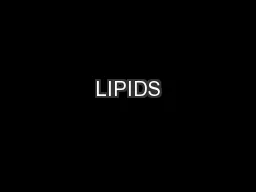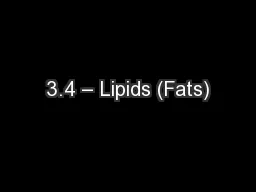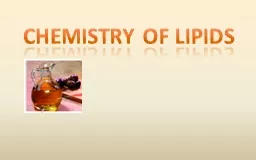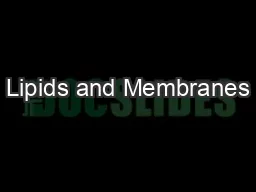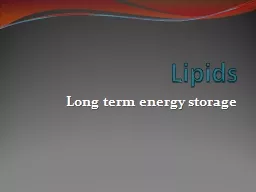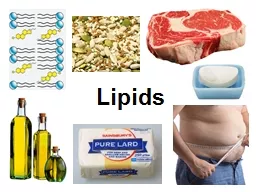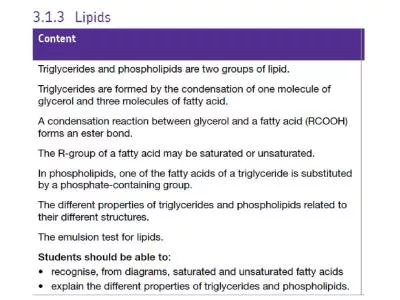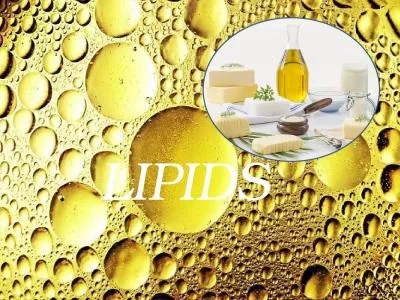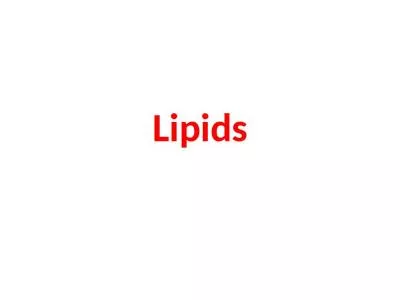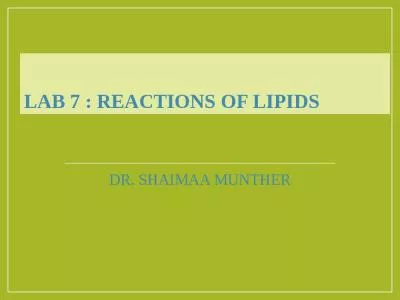PPT-Lipids
Author : giovanna-bartolotta | Published Date : 2016-05-24
Lipids are nonpolar hydrophobic organic compounds insoluble in water soluble in organic solvents ether acetone carbontetrachloride They contain carbon hydrogen
Presentation Embed Code
Download Presentation
Download Presentation The PPT/PDF document "Lipids" is the property of its rightful owner. Permission is granted to download and print the materials on this website for personal, non-commercial use only, and to display it on your personal computer provided you do not modify the materials and that you retain all copyright notices contained in the materials. By downloading content from our website, you accept the terms of this agreement.
Lipids: Transcript
Lipids are nonpolar hydrophobic organic compounds insoluble in water soluble in organic solvents ether acetone carbontetrachloride They contain carbon hydrogen and oxygen sometimes nitrogen and phosphorus . Chapter 29. 2. Lipids. are . biomolecules. that are soluble in organic solvents.. The identity of lipids is defined on the basis of a physical property and not by the presence of a particular functional group.. Lipids. Essential . macronutrients. Provide . energy. Building blocks for cell membranes. Form many important hormones. Help transport fat-soluble nutrients. Contribute to flavor and texture of . food. . 2003-2004. Lipids. 2003-2004. Large biomolecules that are made mostly of carbon and hydrogen with a small amount of oxygen (sometimes Phosphorous).. Lipids . Monomer subunits . Glycerol and 3 fatty acids. Lipids are relatively insoluble in water.. They are soluble in . nonpolar. solvents such as chloroform , diethyl ether, acetone, benzene and ether.. The hydrophobic (water hating) nature of lipids is due to the predominance of hydrocarbon chain.(-CH2-CH2-CH2-) in their structure. 3.4 What Are Lipids?. Lipids. are a diverse group of molecules that contain regions composed almost entirely of hydrogen and carbon. All lipids contain large chains of nonpolar hydrocarbons. Most lipids are therefore hydrophobic and water insoluble. Learning Objectives. Learn what a triglyceride is.. Learn what a fatty acid is.. Learn the structure of a . phospholipid. .. Learn how lipids are tested for.. What is a lipid?. Like most other biochemical substances, lipids contain . Lipid chemistry . Lipid chemistry . Definition . Fats and Oils (triglyceride) . Waxes. Steroids. Fat- soluble vitamins. Phospholipid. Mono- di glycerides . Lipid compounds including: . Classification of Lipids. Pratt & . Cornely. , . Ch. 8. Lipids and Membranes. There is a lot of important biochemistry of lipids.. We won’t cover it all!. The key points for this class have to do with their role in membranes and fat . What elements are Lipids composed of?. Carbon (C) . Hydrogen (H). Oxygen (O). A whole lot of Hydrogen!!!!!. Function in Living Organisms. Lipids usually serve one of three functions: . 1. Energy storage. Cholesterol. Rich in hydrocarbon. Polar group (usually small). Oleic acid. Lipids serve a wide variety of functions. Vitamin K. Surfactants. Protection. Membrane. components. Insulation. Energy storage. are a diverse group of compounds that are insoluble in water but soluble in organic solvents such as ethanol.. The most common types of lipid are . triglycerides. (sometimes known as true fats or neutral fats), but other important lipids include waxes, steroids and cholesterol.. Lipids. : . are a group of naturally occurring substances include a diverse group of organic compounds including . fats, oils, hormones. , and certain components of membranes (. phospholipids. ). All of these substances relatively insoluble in water but soluble in organic solvents like: chloroform, ether and benzene.. are a large and diverse group of naturally occurring organic compounds that share some general . properties. .. General Properties of Lipids. Insoluble . in water.. Soluble in non-polar organic solvents . DR. SHAIMAA MUNTHER. LIPIDS CHEMISTRY . The term “lipids” applies to a class of compounds that are soluble in organic solvents (e.g. alcohol and chloroform) and insoluble in water. . Lipids are essential components of every living cell. .
Download Document
Here is the link to download the presentation.
"Lipids"The content belongs to its owner. You may download and print it for personal use, without modification, and keep all copyright notices. By downloading, you agree to these terms.
Related Documents

